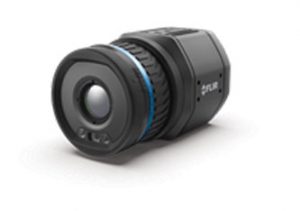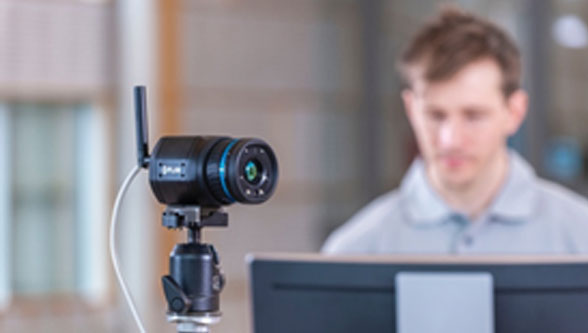Will temperature scanning become the new normal ?
Industrial thermal cameras are useful for detecting elevated skin temperatures to help prevent the spread of infection – By Chris Bainter, Director of Strategic Business Development, FLIR Systems
Thermal imaging technology is used every day across a wide range of businesses and industries, from electricians looking for faulty circuits, to teams of researchers, to large factories. This technology can also make a significant and immediate impact on improving the safety of businesses, governments and the public amidst the coronavirus pandemic.
By repurposing high-resolution thermal imaging for elevated skin temperature screening, businesses have a frontline tool to flag workers, patrons and visitors who may need further health screening designed to prevent infections from spreading within the workplace. When paired with existing public health policy, thermal imaging can help ensure businesses operate as safely as possible within the “new normal” coronavirus is forcing upon society.
Adapting manufacturing to keep facilities running
As governments at all levels across the globe grapple with reopening businesses without a COVID-19 vaccine available, it has become clear that new standards for safety and health must be put into place. In addition to increasing cleaning frequency, the availability of handwashing stations and PPE, society must re-configure processes to meet social distancing guidelines, including monitoring who comes in and out of facilities.
FLIR, a world leader in innovative industrial thermal solutions, is contributing to these efforts to keep on-site persons safe using high-resolution thermal technology. FLIR first began developing thermal camera systems and processes for this purpose during the SARS outbreak that struck East Asia in 2003. Though thermal cameras can’t diagnose COVID-19 or other infections, elevated skin temperature (EST) screening provides a safe and efficient frontline tool to screen a large volume of individuals efficiently. However, not all thermal imaging cameras are suitable for EST scanning.
How to adapt existing technology
FLIR recommends that only those cameras registered with or meeting the recent specifications released by the U.S. Food and Drug Administration (FDA) should be utilized for this purpose. Those devices are capable of pinpointing skin surface temperatures near the tear duct (medially adjacent to the inner canthi), the exterior skin surface that most accurately reflects core body temperature. These cameras include the FLIR Exx-Series, FLIR T-Series, FLIR A320 and the new FLIR A400/A700.
ISO/TR 13154, Medical electrical equipment – Deployment, implementation and operational guidelines for identifying febrile humans using a screening thermograph describes a screening protocol to ensure accurate and effective EST screening with appropriate thermal cameras. Steps below include the ISO/TR 13154 guidance as well as specific notes regarding setting up a FLIR thermal camera for EST screening.
- Place the camera on a tripod or a fixed mount near the entrance to the facility where employees enter for their respective shifts.
- Place a mark for employees to stand, two meters or more away from the camera and the person operating it near a facility entrance. Ensure that employees remain a safe distance from one another while waiting to enter the facility, perhaps through a staggered start time or marked queue.
- Set the camera to scan persons individually at the corner of the eye through the camera’s “screening mode” so that each individual entering the facility can receive the most accurate skin surface temperature reading. Through screening mode, the operator can program an alarm to signal those whose skin temperatures are above the average of temperature of previously-screened individuals.
- Companies should then determine a safe, confidential process through which to refer those whose skin surface temperature is elevated for secondary screening, while protecting the privacy of the screened individual.
- If secondary screening is desired, medical professionals should be onsite to conduct a formal health screening with a medically approved thermometer to confirm a fever. The organization can then make decisions about further testing or other measures including isolation or quarantine.
Responding to the new normal

In most facilities, using a dedicated high-resolution thermal sensing camera will prove to be the least disruptive method to incorporate EST screening into new routines for ensuring employee health and safety. In some cases, companies may temporarily repurpose thermal imaging cameras already in use within an organization by activating FLIR’s proprietary “screening mode,” and by following the steps noted above to begin EST screening operations.
Meanwhile, FLIR has continued to produce its innovative sensing solutions to meet exponential demand across the world, increasing production and maintaining FLIR staff safety by installing its own thermal sensing systems across its critical manufacturing facilities to screen employees. This experience, plus the company’s existing expertise honed across two decades of real-world usage, has enabled it to further support customers who wish to convert existing FDA-registered thermal imaging cameras on hand for skin temperature screening processes.
Supporting business continuity through EST
FLIR has responded to the current crisis with a spirit of innovation, helping users to convert their existing, on-hand thermal cameras for use in EST screening while developing new camera systems and best practices to ensure optimum performance. Implementing skin temperature screening procedures may help to keep employees and customers safe, while also helping companies to achieve business continuity during this health crisis. Combined with a range of other new or stricter employee health and safety protocols, skin temperature screening can help to mitigate the disruption the coronavirus has caused on health, production and the economy overall.



